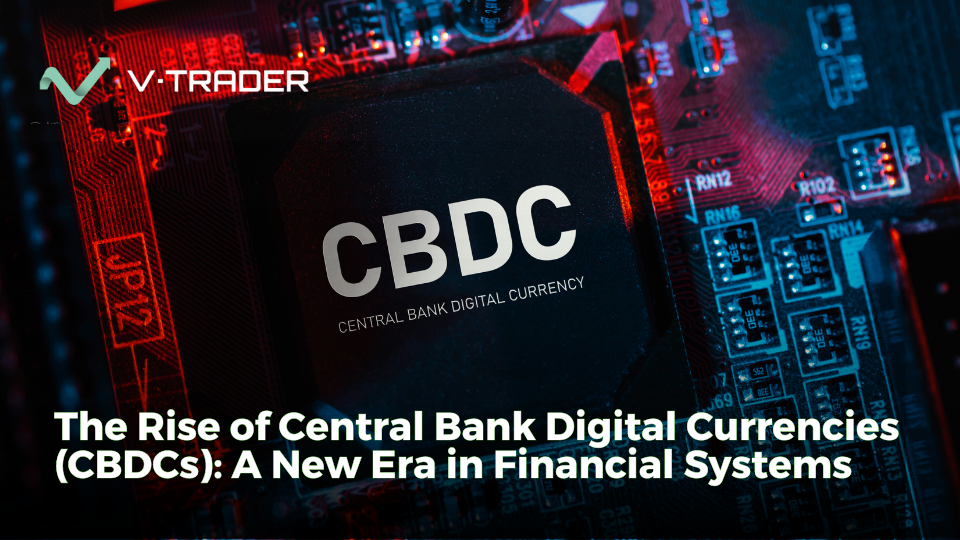Central Bank Digital Currencies (CBDCs) are redefining the way we use our finances by introducing a new digital form of money officially issued by central banks. With the rapid evolution of technology, the global shift toward digital payments is only accelerating, demanding solutions that are both secure and accessible.
CBDCs aim to meet this demand, combining the reliability of traditional banking with the flexibility and speed of advanced technologies.
In this article, we’ll unravel the essence of CBDCs, delving into their purpose, types, benefits, risks, and their growing adoption worldwide. By the end of the article, you’ll gain a clear understanding of what CBDC truly means, how it stands apart from other digital assets, and the profound impact it could have on economies, payments, and consumers across the globe.
What is CBDC?
To have CBDC explained simply, it is the digital form of a nation’s fiat currency, representing a modern, government-backed, and regulated monetary system. Unlike decentralized cryptocurrencies, which operate independently of centralized authorities, CBDCs are issued, managed, and controlled by a country’s central bank.
This centralization ensures that CBDCs hold the same trust, reliability, and legal status as physical cash or bank deposits, with their value directly tied to the nation’s official currency. In essence, what is CBDC? It’s a digital currency designed to combine the stability of traditional central bank money with the efficiency and accessibility of digital payments.
By providing a digital form of the nation’s cash, CBDCs are positioned to modernize financial systems, offering consumers and businesses a secure, government-backed alternative to physical money, while retaining the same value and utility as its physical counterpart.
What’s the Purpose of CBDCs
CBDCs aim to modernize payment systems and enhance the efficiency of domestic and cross-border transactions. They provide a secure and accessible alternative to traditional forms of money, while addressing challenges such as financial exclusion and inefficiencies in current payment infrastructures.
They are designed to complement existing systems, enhance domestic payments, and facilitate seamless transaction processes. Additionally, they help central banks maintain control over the monetary system in an increasingly digital world.
Types of CBDCs
CBDCs can be broadly categorized into two categories based on their intended use:
Retail CBDCs
Retail CBDCs are designed for public use and serve as a digital equivalent to cash. These currencies facilitate everyday transactions for consumers, such as paying for goods and services or transferring money between individuals.
They can operate through digital wallets, integrating seamlessly into modern digital payment systems and are available from your phone.
Wholesale CBDCs
Wholesale CBDCs are reserved for financial institutions, enabling secure, efficient, and large-scale interbank transactions. These digital currencies are instrumental in improving the settlement of payments and streamlining the processes within the banking ecosystem.
How do CBDCs Differ from Other Digital Assets?
CBDCs differ from cryptocurrencies and other digital assets in several key ways:
- Authority: CBDCs are issued by central banks, ensuring their value is backed by the issuing government. Cryptocurrencies like Bitcoin, UNI, or AAVE are decentralized and not tied to any central authority.
- Value Stability: CBDCs maintain a stable value equivalent to fiat currencies, whereas cryptocurrencies can be highly volatile.
- Legal Status: CBDCs are recognized as legal tender, ensuring widespread acceptance.
- Underlying Technology: While cryptocurrencies rely on blockchain, CBDCs may use various technologies tailored for security and scalability.
- Access: While cryptocurrencies require wallets and private keys, CBDCs are accessible to anyone with a digital payment account or device, promoting broader financial inclusion.
Advantages of CBDCs
- Lower Costs and Greater Efficiency
CBDCs can significantly reduce transaction costs by eliminating intermediaries in the payment process and improve transaction speed.
For example, digital payments made with CBDCs can bypass commercial banks for simple transactions, enabling faster and cheaper domestic payments and remittances. This is particularly valuable for cross-border transactions, which often involve complex processes and high fees.
- Improved Financial Inclusion
CBDCs provide an opportunity to bridge the gap between traditional banking systems and underserved populations by providing access to a digital form of central bank money. By offering digital financial services through smartphones or other technology, individuals without access to bank accounts can participate in the economy.
This kind of accessibility can bridge gaps in the modern financial system and foster economic growth within a nation.
- Transparency and Accountability
CBDCs enable greater accountability through traceable transactions. This helps combat illicit activities and promotes compliance with the law.
The use of blockchain or similar distributed ledger technology in CBDCs enhances transparency. Each transaction is recorded in a tamper-proof system, aiding in combating fraud, money laundering, and tax evasion.
- Simplified Cross-Border Transactions
Cross-border payments often involve multiple intermediaries, leading to high costs and delays. CBDCs can simplify these processes, allowing for real-time, cost-effective international transactions.
Risks Associated with CBDCs
- Impact on Credit Lending
The introduction of CBDCs could disrupt traditional monetary systems. For instance, widespread adoption might lead to disintermediation of commercial banks, affecting their ability to lend. Central banks will need to carefully calibrate policies to manage such changes.
- Financial Exclusion
While CBDCs aim to enhance inclusion, they also risk excluding individuals without digital literacy or access to online technology. Policymakers must ensure infrastructure and education are in place to address these barriers.
- Cybersecurity Risks
As digital assets, CBDCs are vulnerable to hacking and other cyber threats. Ensuring robust security measures and regular updates is critical to maintaining trust in the system.
- Privacy Concerns
Although CBDCs enhance transparency by enabling traceable transactions, they also raise concerns about potential overreach in monitoring financial activity. Excessive surveillance of transactions could infringe on consumer privacy, creating a tension between the benefits of accountability and the right to personal freedom.
Striking the right balance will be critical. Central banks must design CBDCs with privacy-preserving features, ensuring that consumers can trust the system while deterring illicit activities.
Innovations such as tiered access, encrypted data storage, and anonymity for small-value payments could help maintain this equilibrium, fostering confidence in a digital currency that respects individual rights.
Global Adoption of CBDC
Countries around the world are at different stages of exploring and implementing CBDCs. For example:
- China: The Digital Yuan is among the most advanced CBDC projects, with several pilot programs already underway. China is modernizing domestic payments and enhancing control over the financial system.
- Eurozone: The European Central Bank is actively researching the feasibility of a Digital Euro to complement existing forms of money.
- United States: The Federal Reserve is exploring the benefits and risks of a digital dollar through consultations and studies. The FED has previously said there is no associated credit or liquidity risk with its emission.
- India: The Reserve Bank of India is testing its e-rupee to streamline domestic payments and financial inclusion.
- Nigeria: The Central Bank of Nigeria is currently experimenting with the eNaira, a digital form of their native currency the Naira.
These initiatives show the growing importance of CBDCs in shaping the world’s future and of the financial system globally.
Frequently Asked Questions
Will CBDC replace cash?
While CBDCs offer a modern, digital form of currency, they are not designed to eliminate physical cash entirely. Instead, they serve as a complementary option, expanding the range of payments available to consumers.
For the foreseeable future, physical currency and CBDCs are expected to coexist, ensuring that individuals can choose the transaction method that best suits their needs.
Can you buy CBDC currency?
Unlike cryptocurrencies, CBDCs are not “bought” in the traditional sense. Instead, they are issued and distributed directly by central banks and exchanged at face value for existing fiat currency. Consumers can access CBDCs by converting physical cash or transferring funds from their bank accounts, ensuring seamless integration with the existing financial system.
This straightforward process underscores a key distinction: while cryptocurrencies are often speculative assets purchased on exchanges, CBDCs serve as a digital form of the nation’s fiat currency, designed for everyday payments and transactions. Their accessibility aims to make them as convenient and widely usable as traditional forms of money.
Are CBDC backed by anything?
Yes, CBDCs are fully backed by their issuing central bank, making them as reliable as a nation’s traditional fiat currency. This backing guarantees that their value remains stable, directly tied to the country’s official monetary system.
Unlike cryptocurrencies, which often experience significant volatility due to speculation, CBDCs are designed to provide the same trust and consistency as cash or bank deposits. This foundation ensures that CBDCs can seamlessly integrate into the economy, offering a digital alternative without compromising the stability of the financial system.
Are CBDC safe?
CBDCs are built with advanced security frameworks to guard against cyber threats, using cutting-edge technology to ensure the integrity of all digital transactions. Central banks employ robust encryption, authentication protocols, and real-time monitoring systems to prevent fraud and unauthorized access. However, like any digital innovation, CBDCs are not immune to evolving cybersecurity risks.
To maintain safety and trust, central banks must continually enhance security measures, adapting to new vulnerabilities and emerging threats. This ongoing vigilance is essential to ensure that CBDCs remain a secure and reliable pillar of the global financial system, offering the stability of traditional currencies in a digital form.
In Conclusion
The rise of Central Bank Digital Currencies (CBDCs) signals the dawn of a new financial era, a bold combination of cutting-edge technology and the stability of central bank money.
These digital innovations promise to not only transform how we conduct payments but also to redefine global economies by bridging gaps in financial access, transparency, and efficiency. With CBDCs, we move closer to a future where digital payments empower individuals and businesses, making economic participation easier than ever before.
As we stand on the brink of this transformation, why not take a step toward mastering the tools that will define tomorrow’s economy? vTrader offers a seamless gateway to explore the world of digital finance, whether you’re a beginner seeking clarity or a professional striving for precision. Join the revolution and discover how vTrader can prepare you for the future of money today.

Steve Gregory is a lawyer in the United States who specializes in licensing for cryptocurrency companies and products. Steve began his career as an attorney in 2015 but made the switch to working in cryptocurrency full time shortly after joining the original team at Gemini Trust Company, an early cryptocurrency exchange based in New York City. Steve then joined CEX.io and was able to launch their regulated US-based cryptocurrency. Steve then went on to become the CEO at currency.com when he ran for four years and was able to lead currency.com to being fully acquired in 2025.


